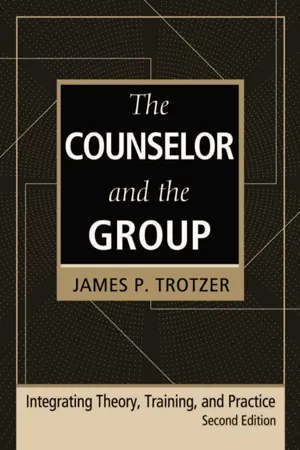Psychology
Group Dynamics
Group dynamics refers to the interactions, relationships, and processes within a group. It encompasses how individuals within a group influence one another, as well as the overall behavior and performance of the group. Understanding group dynamics is important for studying how groups form, function, and evolve, and it can provide insights into leadership, communication, and decision-making within groups.
Written by Perlego with AI-assistance
Related key terms
Related key terms
1 of 4
Related key terms
1 of 3
7 Key excerpts on "Group Dynamics"
- eBook - ePub
- Michele Kehoe(Author)
- 2013(Publication Date)
- Gill Books(Publisher)
9GROUPS AND TEAMSObjectives This chapter will help you to:- Propose a definition of a group.
- Identify the reasons for group formation.
- Describe the difference between a formal and informal group.
- Understand the stages of group development.
- Examine important factors influencing group performance.
- Appreciate the benefits of teamworking.
Group Dynamics is the study of people in groups and also a general term used for group processes. In psychology and sociology, a group is two or more individuals who are associated with each other through social relationships. As a result of the fact that people in groups interact with and influence one another, groups develop a number of dynamic processes that separate them from a random collection of individuals. These group processes include norms, roles, development, need fulfilment, social influence and effects on behaviour. The main focus of the field of Group Dynamics is primarily concerned with small group behaviour.A psychological group is any number of people who (a) interact with each other, (b) are psychologically aware of each other, and (c) perceive themselves to be a group (Schein, 1988).A group is two or more persons who interact with one another in such a manner that each person influences and is influenced by each other person (Shaw, 1991).The concept of interaction is central to the definition of a group. If people do not communicate with each other, they will not be able to share knowledge, beliefs or feelings and therefore will not influence each other. Those who interact with one another through face-to-face meetings, phone calls, e-mail and through many other channels of communication will exchange information and have an effect on each others’ thoughts, feelings and behaviour. Interaction will lead to the development of the group; the quality of the interaction will depend on the type of group. - eBook - ePub
Behavioural Dynamics at the Workplace
A Guide to Introspect, Practice and Transform
- Umashankar K, Charitra H G(Authors)
- 2020(Publication Date)
- Routledge India(Publisher)
People’s defensive mechanisms often get activated as soon as they interact with a group. In a group setting, people always bring with them their perceived self-image and their common fears. During the times of group transaction, individuals frequently try to safeguard their self-image and portray their self-appraised self-image to the group. Besides, other members also have some common fears that propel them to want to seem more sagacious. Consequently, these individuals shed their real identity and dynamically project the fabricated identities to the group. However, this mechanism, which is also called social tuning, is widely accepted in social contexts or workplace contexts.Figure 4.2 Self and Group DynamicsDefinition of Group Dynamics
Group Dynamics can be defined as “the cognitive or behavioural patterns that frequently get fabricated in order to suit the group expectations. The cognitive or behavioural patterns may include thoughts, feelings, attitudes, emotions or different types of expected behaviours.” In the context of the workplace, Group Dynamics are those patterns that the employees manifest through their behaviours or thoughts in order to achieve their professional/interpersonal needs. These dynamics also help the employees to articulate their ideas or opinions across the team, particularly in workplace meetings.Interpersonal relations and Group Dynamics
Group Dynamics is a nexus of psychological adaptations, emotional expressions and behavioural interpretations that are palpable when the individuals come together for achieving a common goal. The intricacies of Group Dynamics are directly aligned with the nature or quality of interpersonal relationships among the team members. Group Dynamics become more sophisticated if the interpersonal relations are not strongly fostered by trust and mutual respect.Figure 4.3 - eBook - ePub
- Paul B. Pedersen, Walter J. Lonner, Juris G. Draguns, Joseph E. Trimble, Maria R. Scharrón-del Río(Authors)
- 2015(Publication Date)
- SAGE Publications, Inc(Publisher)
In adapting this model to train counselors, psychologists, and other mental health professionals, I include a significant amount of time in experiential groups. The Group Dynamics course consists of three components: lecture and discussion of theoretical concepts, experiential groups, and review and application of learning. Ideally, a weekend group relations conference is a part of the Group Dynamics course. The group course always engages students as participant/members of small groups so that they can experience the dynamics that occur in groups and learn to identify and diagnose group behavior. The group experience provides an opportunity for students to learn through the “knowledge of acquaintance” as described above. They are then able to reflect on their experience, applying theoretical concepts to give meaning to behaviors. The method values both emotion and intellect, providing space for direct and honest feedback, allowing those who wish to take the risk of giving voice to experience. Interpersonal and group learning is a process of internalizing and incorporating “felt experience into the inner world of fantasy and reason” (Rice, 1975, p. 72).Racial and Cultural Group Dynamics
Group Dynamics are related to the stages of groups’ development (Tuckman, 1965). When a group is forming, members are more inclined to polite engagement, as they are getting to know each other; as time passes, conflicts emerge, resolutions are made, group norms are established, and the search for productive work on the group’s task takes place. The dynamic interactions that occur interpersonally and for the group determine how the group moves through the various stages of development. Bion (1961) has described the group as an entity that functions on two levels: as a “work group” and as a “basic assumption group.” The work group works diligently toward accomplishing its tasks and objectives, usually in a predetermined structure (Rioch, 1975). The work group is functional; members contribute in various clearly defined roles to achieve a task in a given period of time. However, groups do not always behave in a sensible manner; as Rioch (1975) observes, “Man seems to be a herd animal who is often in trouble with his herd” (p. 23). - eBook - ePub
The Counselor and the Group, fourth edition
Integrating Theory, Training, and Practice
- James P. Trotzer(Author)
- 2013(Publication Date)
- Routledge(Publisher)
5
Process to Practice
Group work practice combines personality dynamics, Group Dynamics and systemic dynamics to generate interaction that respects the person, mobilizes the resources of the group and addresses the purpose for which the group is convened (Trotzer, 2000, p. 10).Turning Group Dynamics into Form and Function
Developmental psychology’s most significant contribution to our knowledge of human beings emanates from the basic premise that by understanding normal functionality, we are able to facilitate and enhance normality as well as accommodate to and correct abnormality. Its methodology entails studying organism change phenomena and identifying sequences of events that constitute normal growth and development over the organism’s life cycle. Once clarified, these sequences or stages serve as the reference base when any individual unit of the organism is encountered. Consequently, development principles are relevant to any organism or organization that evolves through developmental phases that have sequential and life cycle dimensions. Individuals, relationships, systems, and groups all qualify as being developmental in nature. As we have seen in the previous chapter, the group process is a specific example of the developmental psychology perspective.Developmental Perspective
Simply understanding the development of a particular type of group is insufficient since the utility of that process only has meaning if transformed into a pragmatic application that helps people change and gets work accomplished. In other words, process dynamics must be translated into form and function as well as serve as our evaluative criteria for determining if the process is evolving appropriately. This chapter is designed to bridge the gap between process and practice. The developmental concept most relevant to this chapter is that given typical conditions, growth or change in any organism unfolds predictably in a sequence of stages each of which involves certain developmental tasks (Havighurst & Neugarten, 1968). These tasks must be addressed for successful completion of a particular stage to occur and serve as the foundation for proceeding to the next stage. These stages are the building blocks of the organism’s growth and development. How they are addressed determines how a particular organism will adjust and function. Over time, how these tasks are handled will indicate where the organism will fall on the continuums of normality and functionality and whether it will be typical or atypical. The stages of the group process contain such developmental tasks. They are embedded in the interactional dynamics of the ongoing process. The purpose of this chapter is to identify those tasks and demonstrate their relevance to the structure and utility of the group as a therapeutic change agent or productive work setting. Each group stage will be deconstructed in terms of specific developmental tasks. Implications for using the tasks as a basis for structuring the group process will be discussed. The phases of an individual group session which generally reflect process dynamics and developmental tasks in prototypical form will also be described. The chapter will conclude with a set of task related group activities. - eBook - ePub
- Gershon Tenenbaum, Robert C. Eklund, Gershon Tenenbaum, Robert C. Eklund(Authors)
- 2020(Publication Date)
- Wiley(Publisher)
15 Psychology of Group Dynamics : Key Considerations and Recent DevelopmentsMark R. Beauchamp, Desmond McEwan, and Colin M. WiertsUniversity of British Columbia, Vancouver, British Columbia, CanadaIntroduction
The existence of groups pervades many aspects of human life. They shape how we develop, are nurtured, and socialize through families and close friendships. They influence how we learn, develop knowledge, and acquire key competencies, with classes used as the predominant organizational structure within schools and most educational institutions. They also affect how many people work, through employment in project teams, health care units (involving doctors, nurses, and various other care providers), aviation crews, military platoons, police deployment units, and so on (McEwan, Ruissen, Eys, Zumbo, & Beauchamp, 2017 ). Of particular relevance to this chapter, groups also play a major role within both sport and exercise settings. For example, in sport, athletes are often recruited to perform within teams. In exercise programs (Harden et al., 2015 ), as well as rehabilitation (Raymond et al., 2016 ) and chronic disease prevention and management programs (Gavarkovs, Burke, & Petrella, 2016 ), groups are often used to support individual members in sustaining their long‐term involvement in health‐enhancing physical activity.The study of groups has a rich history within the field of psychology more broadly, and specifically within sport and exercise psychology. Around the turn of the 20th century, several researchers in both Europe and North America became interested in what happens when individuals perform tasks alongside, and in the presence of, other people. For example, between 1882 and 1887, the French engineer Max Ringelmann conducted a series of investigations into the performance of workers pulling a load either alone or with others, with this work eventually being published several years later (Ringelmann, 1913 ; see also Kravitz & Martin, 1986 ). He found that as group size increases (on a rope‐pulling task), the relative contribution in terms of effort per person decreases. Around the same time, on the other side of the Atlantic, the American psychologist Norman Triplett observed that cyclists pedal faster when in the presence of others than when alone (Triplett, 1898 , Part I). He subsequently conducted a well‐known laboratory‐based experiment (Triplett, 1898 , Part II) designed to examine this “social facilitation effect” (see also Chapter 17 ), with children performing a physical (fishing reel) task. Although some have suggested that Triplett’s conclusions were overstated (Stroebe, 2012 ), this work was seminal in contributing to the fields of both social and sport psychology by highlighting the importance of interpersonal and group influences. Notwithstanding these early contributions, the concerted and systematic study of group processes can rightly be attributed to the pioneering work of Kurt Lewin and his colleagues (Lewin, 1947 , 1951 ; Lewin, Lippitt, & White, 1939 - eBook - ePub
Learning in Groups
A Handbook for Face-to-Face and Online Environments
- David Jaques, Gilly Salmon(Authors)
- 2007(Publication Date)
- Routledge(Publisher)
CHAPTER 2
STUDIES OF GROUP BEHAVIOUR
Chapter two explores the essential characteristics of effective groups and a range of issues affecting Group DynamicsOver the past 50 years a wealth of information has been compiled by social psychologists working with experimental groups in laboratory settings. Some have focused on individual behaviour, some on the individual as a group member or on the group as a whole and others on intergroup behaviour. They offer us special insights into group behaviour that can help us with learning in groups too. Group members and participants often find research-based concepts and principles helpful in understanding what's going on and what options there may be in dealing effectively with them.However, a little word of warning for practitioners. Most of the work of social psychologist concentrates on the group performing practical tasks rather than developing learning or personal growth. The behaviours of long-established groups over a period of time in learning and teaching settings, compared to groups brought together for experimental purposes, may be rather different. Experiments rarely touch upon the complex phenomena of interaction which dominate many learning groups, including the expectations of future interactions, which develop over time over time or the awareness of roles and responsibilities outside the group meeting (Olivera and Strauss 2004; Galanes 2003, citing Stohl and Putnam 1990 and 1994). We now have online groups providing direct evidence over long periods of time without the physical presence of observers. Researchers gather evidence through transcripts of authentic processes with an ongoing group. Online group processes and be monitored through a structured developmental process or ‘scaffold’ (see page 277 - eBook - ePub
Core Principles of Group Psychotherapy
An Integrated Theory, Research, and Practice Training Manual
- Francis J. Kaklauskas, Les R. Greene, Francis J. Kaklauskas, Les R. Greene(Authors)
- 2019(Publication Date)
- Routledge(Publisher)
Module 2Group Structure and Group Dynamics
Passage contains an image
3 Group Structure and Levels of Analysis
Les R. GreeneIntroduction
What occurs in any moment can be regarded as the product of many factors acting independently and interactively, including:- The members’ and leader’s personalities, agendas, and needs.
- The roles – both task oriented and emotion-oriented -that the members and leaders are taking.
- The tasks and goals of the group.
- The group’s current social-emotional state or climate.
- The embedding context of the group including:
- the constraints, resources, and values of the specific setting in which the group is located (e.g., outpatient agency or clinic).
- the culture or mix of cultures within and surrounding the group.
- the unique history and trajectory of this group.
- historical and current dynamics within the larger societal and sociopolitical contexts.
All of these factors operate to create a unique group ecology , and in this way each group has its own distinctive journey. At the same time, many commonalities and regularities exist across groups. Group events and interchanges unfold at times in idiosyncratic and unforeseen ways, and at other times in predictable ways consistent with our theories or past experiences. This chapter focuses on structural perspectives of groups, including the boundaries and internal components that define the group. This conceptual framework helps us understand what occurs not only in psychotherapy groups, but also in other groups such as work groups or other task groups.The Structural Perspective
Figures 3.1 and 3.2
Index pages curate the most relevant extracts from our library of academic textbooks. They’ve been created using an in-house natural language model (NLM), each adding context and meaning to key research topics.
Explore more topic indexes
Explore more topic indexes
1 of 6
Explore more topic indexes
1 of 4






